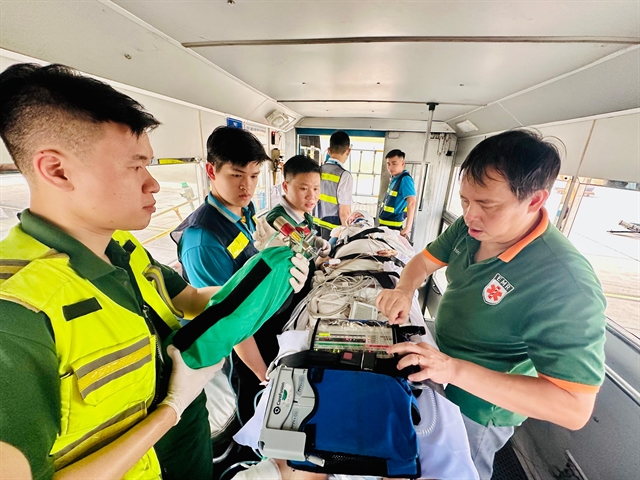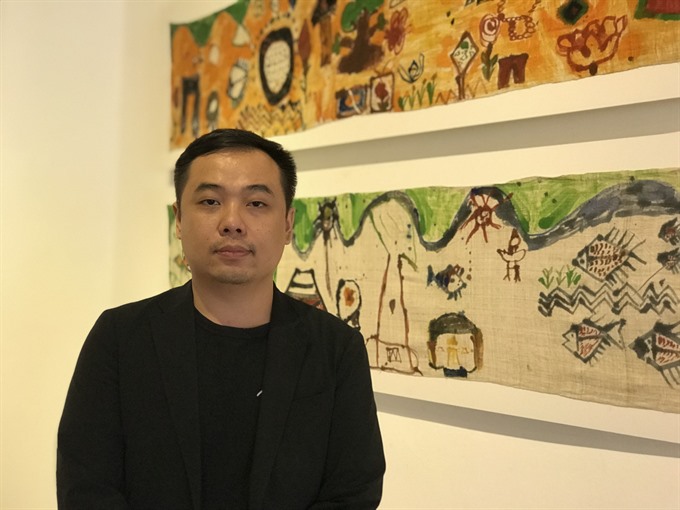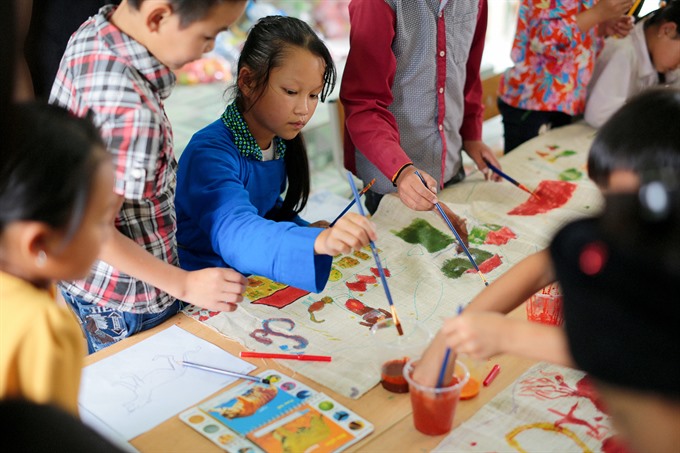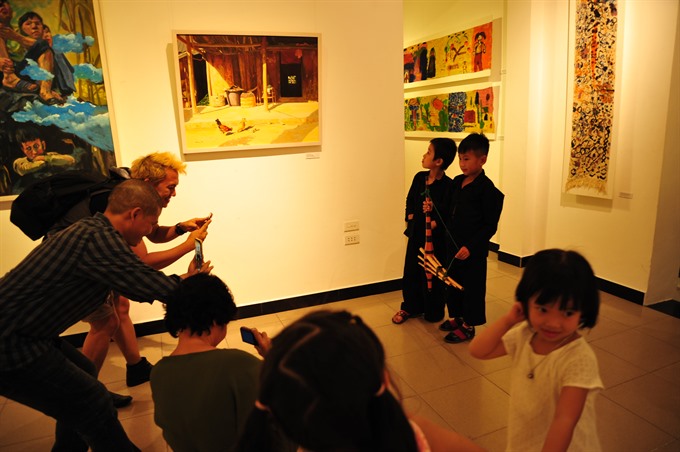 Expat Corner
Expat Corner

Art lovers have been fllocking to an art show in downtown Hà Nội. Many of them have been stunned at the dozens of paintings inspired by the glorious mountains and karst plateau of northern Hà Giang Province.
 |
| Magic mountains: Painter Đoàn Xuân Hùng guides children in Hà Giang Province to decorate their school. — Photo courtesy of Wei Kuo |
by Lê Hương
Art lovers have been flocking to an annual art show in downtown Hà Nội. Many of them have been stunned at the dozens of paintings inspired by mountains and karst plateau of northern province of Hà Giang.
Titled Sơn Lục (Viridity Peak) the exhibition showcases not only artworks by 25 painters from the Hà Nội Fine Arts College, who are taking part in a charity project named Ngôi Sao Miền Núi 2017 (Mountain Stars), but also works by children from Tùng Vài, Đông Hà and Cán Tỷ communes in Quản Bạ District, Hà Giang.
The exhibition is the fourth held by art researcher Wei Kuo from Taiwan.
“The most special feature of this event is a set of paintings drawn on hand-woven linen cloth by children,” Kuo said, “This year, we have not only taught children to draw, use colours, judge beauty, but also guided them how to draw on linen cloth using water colour, acrylic, natural colours and wax.”
Some of the paintings on cloth are displayed at the exhibition, the rest have been sent to HCM city-based Huulala design house to be used on clothes and accessories. Most of the proceeds will be sent to the children and local comunity.
“We want the children and locals to understand that painting does not only provide spiritual values but also creates sustainable income for the community,” Kuo said.
 |
| Teacher: Researcher Wei Kuo poses for a photo at the exhibition Viridity Peak. — VNS Photo Lê Hương |
Since 2014, Kuo organised 50 young painters to make field trips to remote areas to teach local children to draw and help decorate their schools.
The project has taught basic drawing to 600 children of six to ten years old in Hà Giang Province and Cô Tô District in Quảng Ninh Province.
Explaining how he formed the project idea, Kuo said he has discovered a gap between the creative thought of contemporary artists with their audiences.
“That’s why many people find contemporary fine art works strange,” he said. “It’s a challenge to the development of Vietnamese contemporary fine arts. In recent years, many Vietnamese artists want to socialise contemporary fine arts and we have discussed the matter a lot. I found out that nature and native culture in Hà Giang can help refresh artists, to make them get closer approach to ethnic groups and to get more inspirations. At the same time, they can be more aware of their duty to the community. The idea of the project was born from that thought.”
 |
| Joining in: Children join a drawing lesson by members of Mountain Star project in Hà Giang Province. — Photo courtesy of Wei Kuo |
Before each trip, the artists gather and invite an expert to talk about traditional customs of the groups living in the destination. Then they draft out a plan to teach children simple shapes, structures, mixing colours based on traditional decorative patterns popular in that minority group, even tales of that group.
“We want to bring along knowledge and awareness of fine arts to the children, encourage them to preserve their identity,” Kuo said, “Ethnic groups in remote areas have kept valuable native traditions that have long been lost among modern society.”
At the end of each field trip, the painters display paintings at an exhibition in Hà Nội and then in Taiwan. Proceeds are spent on the next field trip, and spared for needy children and schools in the localities.
Wei Kuo, who is now doing his PhD research on Vietnamese contemporary fine arts at Hà Nội National University, has a special reason to stick to Hà Giang for so long.
After completing his BA in Colonial History in Britain, Kuo wanted to continue his father’s step as an art dealer, who has traded fine art works in Taiwan and collected some paintings by Vietnamese painters.
He chose Việt Nam among other neighbouring countries as it possessed one of the most potentital markets of fine arts.
In a field trip to Hà Giang in 2013, he met a woman of Bố Y minority group, who worked as a guide for his group to tour the karst plateau. He then fell in love with her and decided to stay longer with Hà Giang people by marrying her.
“My parents-in-law are both State staff so they act very well to me,” he said. “I found my wife as well as other Vietnamese women living in mountainous area have great characters. They take great care of their husbands and support their husband in careers.”
 |
| Photo time: Visitors at the Viridity Peak show (left) take photos of children from Hà Giang Province. — Photo courtesy of Wei Kuo |
Though Việt Nam and Taiwan share a lot in common, such as influences from Confucianism and Buddhism, in big cities, industrial style of living has gradually changed traditional customs and tradition, he said.
“People no longer invite elders to meals,” he said, “But that custom is still preserved in many Vietnamese families. That’s why I have found warmth when visiting families here.”
Kuo said he keeps travelling between Hà Nội and Hà Giang, where his wife and three-year-old girl twins are living.
“I love Vietnamese food, especially tiết canh vịt (blood jelly made from duck blood) in Hà Giang style,” he said, “Locals raise ducks on terrace rice field. The ducks eats unhusked rice, so their meat taste delicious and healthy.”
Kuo visits his family in Taiwan once or twice a year, while his father, an art collector, supports him in the project and sells most of the paintings.
Kuo said he always admires Vietnamese fine arts with a special lacquer style created by painters at the Indochina Fine Arts College and the then French teachers although the art stemmed from China.
“Vietnamese lacquer is an art of the East, but it combines techniques of the West,” he said, “It gathers Eastern phylosophy of Yin and Yang inside.”
Painter Nguyễn Trường Linh, head of Fine Arts Department, Hà Nội College of Art, who have co-ordinated with Kuo for five years, said Kuo led a modest life and was eager to know about Việt Nam.
“He inherits various good characteristics from his father, an art dealer,” he said, “Kuo holds a sharp understanding on people.”
“His only weak point may be the fact that he loves Vietnamese people too much,” Linh jokes. — VNS




